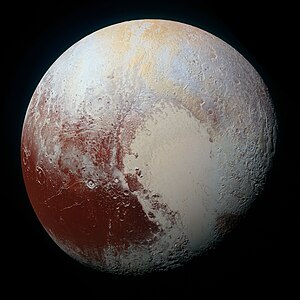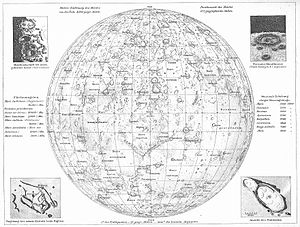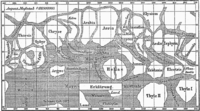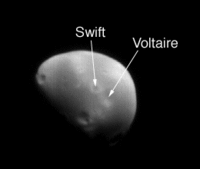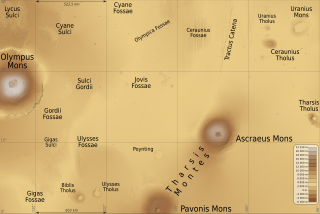| Feature | Pronunciation [note 1] | Description | Designation |
|---|
| Albedo feature | | An area which shows a contrast in brightness or darkness (albedo) with adjacent areas. This term is implicit. | AL |
| Arcus, arcūs | | Arc: curved feature | AR |
| Astrum, astra | , | Radial-patterned features on Venus | AS |
| Catena, catenae | , | A chain of craters e.g. Enki Catena. | CA |
| Cavus, cavi | , | Hollows, irregular steep-sided depressions usually in arrays or clusters | CB |
| Chaos | | A distinctive area of broken or jumbled terrain e.g. Iani Chaos. | CH |
| Chasma, chasmata | , | Deep, elongated, steep-sided depression e.g. Eos Chasma. | CM |
| Collis, colles | , | A small hill or knob. | CO |
| Corona, coronae | , | An oval feature. Used only on Venus and Miranda. | CR |
| Crater, craters | | A circular depression (in most cases created by impact event). This term is implicit. | AA |
| Dorsum, dorsa | , | Ridge, sometimes called a wrinkle ridge e.g. Dorsum Buckland. | DO |
| Eruptive center | | An active volcano on Io. This term is implicit. | ER |
| Facula, faculae | , | Bright spot | FA |
| Farrum, farra | , | Pancake-like structure, or a row of such structures. Used only on Venus. | FR |
| Flexus, flexūs | | Very low curvilinear ridge with a scalloped pattern | FE |
| Fluctus, fluctūs | , | Terrain covered by outflow of liquid. Used on Venus, Io, Titan, and Mars. | FL |
| Flumen, flumina | , | Channel on Titan that might carry liquid | FM |
| Fossa, fossae | , | Long, narrow, shallow depression | FO |
| Fretum, freta | , | Strait of liquid connecting two larger areas of liquid. Used only on Titan. | FT |
| Insula, insulae | , | Island (islands), an isolated land area (or group of such areas) surrounded by, or nearly surrounded by, a liquid area (sea or lake). Used only on Titan. | IN |
| Labes, labēs | , | Landslide debris. Used only on Mars and 1 Ceres. | LA |
| Labyrinthus, labyrinthi | , | Complex of intersecting valleys or ridges. | LB |
| Lacuna, lacunae | , | Irregularly shaped depression having the appearance of a dry lake bed. Used only on Titan. | LU |
| Lacus, lacūs | | A "lake" or small plain on Moon and Mars; on Titan, a "true lake" of dark liquid hydrocarbons or a small, dark plain with discrete, sharp boundaries; on Pluto, a small isolated glacier | LC |
| Landing site name | Lunar features at or near Apollo landing sites | LF |
| Large ringed feature | Cryptic ringed features | LG |
| Lenticula, lenticulae | , | Small dark spots on Europa | LE |
| Linea, lineae | , | Dark or bright elongate marking, may be curved or straight | LI |
| Lingula, lingulae | , | Extension of plateau having rounded lobate or tongue-like boundaries | LN |
| Lobus | | Lobes of contact binaries. Currently used only on Arrokoth. | LO |
| Macula, maculae | , | Dark spot, may be irregular | MA |
| Mare, maria | , | A "sea": on the Moon, a low albedo, relatively smooth plain, generally of large extent; on Mars, dark albedo area, e.g. Mare Erythraeum; on Titan, large expanses of dark materials thought to be liquid hydrocarbons, e.g. Ligeia Mare. | ME |
| Mensa, mensae | , | A flat-topped prominence with cliff-like edges, i.e. a mesa. | MN |
| Mons, montes | , | Mons refers to a mountain. Montes refers to a mountain range. | MO |
| Oceanus | | Very large dark area. The only feature with this designation is Oceanus Procellarum. | OC |
| Palus, paludes | , | "Swamp"; small plain. Used on the Moon and Mars. | PA |
| Patera, paterae | , | Irregular crater, or a complex one with scalloped edges e.g. Ah Peku Patera. Usually refers to the dish-shaped depression atop a volcano. | PE |
| Planitia, planitiae | , | Low plain e.g. Amazonis Planitia. | PL |
| Planum, plana | , | A plateau or high plain e.g. Planum Boreum. | PM |
| Plume, plumes | | A cryovolcanic feature on Triton. This term is currently unused. | PU |
| Promontorium, promontoria | , | "Cape"; headland. Used only on the Moon. | PR |
| Regio, regiones | , | Large area marked by reflectivity or color distinctions from adjacent areas, or a broad geographic region | RE |
| Reticulum, reticula | , | reticular (netlike) pattern on Venus | RT |
| Rima, rimae | , | Fissure. Used only on the Moon and 21 Lutetia. | RI |
| Rupes, rupēs | , | Scarp | RU |
| Saxum, saxa | , | Boulder or rock | SA |
| Satellite feature | | A feature that shares the name of an associated feature, for example Hertzsprung D. | SF |
| Scopulus, scopuli | , | Lobate or irregular scarp | SC |
| Serpens, serpentes | , | Sinuous feature with segments of positive and negative relief along its length | SE |
| Sinus, sinūs | | "Bay"; small plain on Moon or Mars, e.g. Sinus Meridiani; On Titan, bay within bodies of liquid. | SI |
| Sulcus, sulci | , | Subparallel furrows and ridges | SU |
| Terra, terrae | , | Extensive land mass e.g. Arabia Terra, Aphrodite Terra. | TA |
| Tessera, tesserae | , | An area of tile-like, polygonal terrain. This term is used only on Venus. | TE |
| Tholus, tholi | , | Small domical mountain or hill e.g. Hecates Tholus. | TH |
| Undae, undae | | A field of dunes. Used on Venus, Mars and Titan. | UN |
| Vallis, valles | , | A valley e.g. Valles Marineris. | VA |
| Vastitas, vastitates | , | An extensive plain. The only feature with this designation is Vastitas Borealis. | VS |
| Virga, virgae | , | A streak or stripe of color. This term is currently used only on Titan. | VI |
